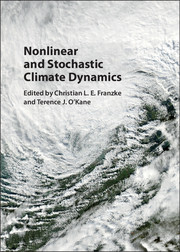Book contents
- Frontmatter
- Contents
- List of Figures
- List of Contributors
- Preface
- 1 Challenges for Ice Age Dynamics: A Dynamical Systems Perspective
- 2 Tipping Points in the Climate System
- 3 Atmospheric Teleconnection Patterns
- 4 Atmospheric Regimes: The Link between Weather and the Large-Scale Circulation
- 5 Low-Frequency Regime Transitions and Predictability of Regimes in a Barotropic Model
- 6 Complex Network Techniques for Climatological Data Analysis
- 7 On Inference and Validation of Causality Relations in Climate Teleconnections
- 8 Stochastic Climate Theory
- 9 Stochastic Subgrid Modelling for Geophysical and Three-Dimensional Turbulence
- 10 Model Error in Data Assimilation
- 11 Long-Term Memory in Climate: Detection, Extreme Events, and Significance of Trends
- 12 Fractional Stochastic Models for Heavy Tailed, and Long-Range Dependent, Fluctuations in Physical Systems
- 13 Modelling Spatial Extremes Using Max-Stable Processes
- 14 Extreme Value Analysis in Dynamical Systems: Two Case Studies
- Index
14 - Extreme Value Analysis in Dynamical Systems: Two Case Studies
Published online by Cambridge University Press: 26 January 2017
- Frontmatter
- Contents
- List of Figures
- List of Contributors
- Preface
- 1 Challenges for Ice Age Dynamics: A Dynamical Systems Perspective
- 2 Tipping Points in the Climate System
- 3 Atmospheric Teleconnection Patterns
- 4 Atmospheric Regimes: The Link between Weather and the Large-Scale Circulation
- 5 Low-Frequency Regime Transitions and Predictability of Regimes in a Barotropic Model
- 6 Complex Network Techniques for Climatological Data Analysis
- 7 On Inference and Validation of Causality Relations in Climate Teleconnections
- 8 Stochastic Climate Theory
- 9 Stochastic Subgrid Modelling for Geophysical and Three-Dimensional Turbulence
- 10 Model Error in Data Assimilation
- 11 Long-Term Memory in Climate: Detection, Extreme Events, and Significance of Trends
- 12 Fractional Stochastic Models for Heavy Tailed, and Long-Range Dependent, Fluctuations in Physical Systems
- 13 Modelling Spatial Extremes Using Max-Stable Processes
- 14 Extreme Value Analysis in Dynamical Systems: Two Case Studies
- Index
Summary
Abstract
We give here a brief summary of classical Extreme Value Theory for random variables, followed by that for deterministic dynamical systems, which is a rapidly developing area of research. Here we would like to contribute to that by conducting a numerical analysis designed to show particular features of extreme value statistics in dynamical systems, and also to explore the validity of the theory. We find that formulae that link the extreme value statistics with geometrical properties of the attractor hold typically for high-dimensional systems – whether a so-called geometric distance observable or a physical observable is concerned. In very low-dimensional settings, however, the fractality of the attractor prevents the system from having an extreme value law, which might well render the evaluation of extreme value statistics meaningless and so ill-suited for application.
Introduction
The climate system is a multiscale nonlinear dynamical system. The application of mathematical theories to it that approximate observables by simple random variables cannot be expected to always work. The example that will be examined here is classical Extreme Value Theory (EVT). Its main result, the Extreme Value Theorem due to Fisher and Tippett (1928) and Gnedenko (1943), states that uncorrelated random variables, no matter how they are distributed, share common features in their statistics at high quantiles: there is a family of distribution functions, that of the Generalized Extreme Value Distribution (GEVD), that universally describe the statistics in the tails. It is a limit theorem for extremes, similar to the Central Limit Theorem for means of random variables. The great value in this universality would be the possibility of predicting occurrence frequencies of events that have never been observed.
In the last century a scientific awakening took place, recognizing that random-like unpredictable phenomenon can be down to not only ‘chance’ but ‘dynamical instabilities’ and ‘uncertainties’, errors in observations, too. On this paradigm was built chaos theory, which describes in great detail aspects of the chaotic behaviour of deterministic nonlinear dynamical systems governed by differential equations devoid of any notion of chance.
- Type
- Chapter
- Information
- Nonlinear and Stochastic Climate Dynamics , pp. 392 - 429Publisher: Cambridge University PressPrint publication year: 2017
- 1
- Cited by



